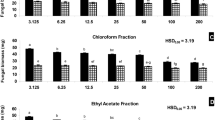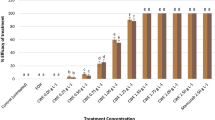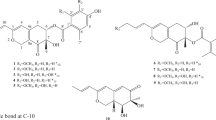Abstract
IN a recent communication, Grosjean1 reported on the fungicidal activity of aqueous extracts from the bark of Populus species. In our laboratory the bark of Populus candicans has been studied in more detail. It was found to contain several compounds of low fungistatic activity such as pyrocatechol, salicin, saligenin and salicylic acid derivatives, whereas the test results revealed that substances of relatively high activity were also present. Two of these compounds were isolated as follows.
This is a preview of subscription content, access via your institution
Access options
Subscribe to this journal
Receive 51 print issues and online access
$199.00 per year
only $3.90 per issue
Buy this article
- Purchase on Springer Link
- Instant access to full article PDF
Prices may be subject to local taxes which are calculated during checkout
Similar content being viewed by others
References
Grosjean, J., Nature, 165, 853 (1950).
Manten, A., Klöpping, H. L., and van der Kerk, G. J. M., “Ant. van Leeuwenhoek”, 16, 282 (1950).
Gomberg, M., and Buchler, C. C., J. Amer. Chem. Soc., 42, 2063 (1920).
Naudin, E., Bull. Soc. Chim. France, 485 (1884).
Francis, F., Watkins, C. M., and Wallington, R. W., J. Chem. Soc., 121, 2804 (1922).
Grün, A., Ulbrich, E., and Krczil, F., Z. angew. Chem., 39, 424 (1926).
Author information
Authors and Affiliations
Rights and permissions
About this article
Cite this article
KLÖPPING, H., VAN DER KERK, G. Antifungal Agents from the Bark of Populus candicans. Nature 167, 996–997 (1951). https://doi.org/10.1038/167996a0
Issue Date:
DOI: https://doi.org/10.1038/167996a0
This article is cited by
-
Winter chemical defense of Alaskan balsam poplar against snowshoe hares
Journal of Chemical Ecology (1990)
-
Response of three root rot fungi to strawberry phenolics and the relation of phenolics to disease resistance
Mycopathologia (1976)
-
Interaction between phenolic substances and microbial polysaccharides in soil aggregation
Plant and Soil (1972)
-
Trichocarpin, ein neues als Resistenzfaktor bedeutsames Phenolglykosid aus Pappelrinde
Die Naturwissenschaften (1964)
-
Antibakterielle und antifungale Hemmstoffe in höheren Pflanzen
Forstwissenschaftliches Centralblatt (1964)
Comments
By submitting a comment you agree to abide by our Terms and Community Guidelines. If you find something abusive or that does not comply with our terms or guidelines please flag it as inappropriate.



